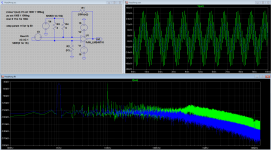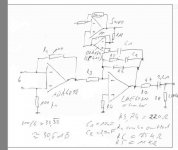Here we go :
The SSTPP, super simple transimpedance pre pre.
The 22 Ohm and 330uF cap decoupling i learned from Bonsai.
It works also without the 22 Ohm resistors but they give a good measure of PSU rejection in the treble where PSU rejection in Opamps is limited.
I forgot a 100nF from Pin 4 to Pin 7. I prefer the single decoupling cap solution, that i copied from D.Self. It works as well as two to ground and is more economical although this 10 cents may matter more in England then they do where i live C:
Well actually the argument is not to shunt into ground but bypassing the chip.
There is a 50 Ohm resistor at the output for stability into capacitive load. The ADA4898 can swing around more current then most so even 20 Ohm is more then OK.
The feedback resistor is 100 Ohm, the highest value recommended to avoid peaking in the highest reaches. With a Denon DL103 with 40 Ohm gain will be to low. Then you have to increase the feedback resistor say to 500 Ohm but then a cap has to be placed parallel to that bigger resistor. I found that surprising small caps like 10pF make the deal. The circuit is DC coupled without servo without problem. Maybe a very high impedance of the cartridge may cause some offset. That can be balanced by putting the same amount of resistance then the cartridge has from Pin 3 to ground at the expense of 3dB more noise.
The SSTPP, super simple transimpedance pre pre.
The 22 Ohm and 330uF cap decoupling i learned from Bonsai.
It works also without the 22 Ohm resistors but they give a good measure of PSU rejection in the treble where PSU rejection in Opamps is limited.
I forgot a 100nF from Pin 4 to Pin 7. I prefer the single decoupling cap solution, that i copied from D.Self. It works as well as two to ground and is more economical although this 10 cents may matter more in England then they do where i live C:
Well actually the argument is not to shunt into ground but bypassing the chip.
There is a 50 Ohm resistor at the output for stability into capacitive load. The ADA4898 can swing around more current then most so even 20 Ohm is more then OK.
The feedback resistor is 100 Ohm, the highest value recommended to avoid peaking in the highest reaches. With a Denon DL103 with 40 Ohm gain will be to low. Then you have to increase the feedback resistor say to 500 Ohm but then a cap has to be placed parallel to that bigger resistor. I found that surprising small caps like 10pF make the deal. The circuit is DC coupled without servo without problem. Maybe a very high impedance of the cartridge may cause some offset. That can be balanced by putting the same amount of resistance then the cartridge has from Pin 3 to ground at the expense of 3dB more noise.
Attachments
What is this animal ? http://www.ti.com/lit/ds/symlink/lmh6554.pdf
They come faster then i can digest the spec sheets.
OK, it runs on only plus-minus 5.5V and draws a lot of current but watch the slew rate and the bandwidth !
They come faster then i can digest the spec sheets.
OK, it runs on only plus-minus 5.5V and draws a lot of current but watch the slew rate and the bandwidth !
Here we go :
The SSTPP, super simple transimpedance pre pre.
The 22 Ohm and 330uF cap decoupling i learned from Bonsai.
It works also without the 22 Ohm resistors but they give a good measure of PSU rejection in the treble where PSU rejection in Opamps is limited.
I forgot a 100nF from Pin 4 to Pin 7. I prefer the single decoupling cap solution, that i copied from D.Self. It works as well as two to ground and is more economical although this 10 cents may matter more in England then they do where i live C:
Well actually the argument is not to shunt into ground but bypassing the chip.
There is a 50 Ohm resistor at the output for stability into capacitive load. The ADA4898 can swing around more current then most so even 20 Ohm is more then OK.
The feedback resistor is 100 Ohm, the highest value recommended to avoid peaking in the highest reaches. With a Denon DL103 with 40 Ohm gain will be to low. Then you have to increase the feedback resistor say to 500 Ohm but then a cap has to be placed parallel to that bigger resistor. I found that surprising small caps like 10pF make the deal. The circuit is DC coupled without servo without problem. Maybe a very high impedance of the cartridge may cause some offset. That can be balanced by putting the same amount of resistance then the cartridge has from Pin 3 to ground at the expense of 3dB more noise.
Joachim, why not VF2 direct to pin 3, then disconnect pin3 from ground, add a 100 ohm resistor to ground (from pin 3). It should improve common mode noise picked up in the cartridge and cartridge wiring. Can you give it a try? And a 100 nF between pin 4 and 7.
Last edited:
Hi guys,
glad to see you are making progress with paradise and all the fuss is back to this thread
I dropped by to post my final build of Joachims naked truth. ...
Very, very, very nice build, where is my 'I like it'-button.

Yes Frans, that will improve the performance. I will try it.
I am not sure if the 100 Ohm will worsens the Signal-Noise. Maybe not because the input is shorted by the cartridge.
I have to eat the humble pie, after reading your post more carefully I see that you did mention the 100 nF and the 100 Ohm.
http://en.wikipedia.org/wiki/Humble_pie
Yes Frans, that will improve the performance. I will try it.
I am not sure if the 100 Ohm will worsens the Signal-Noise. Maybe not because the input is shorted by the cartridge.
Joachim, I ran this through the simulator. For equal gain you need (in 'balanced' mode) to halve the resistor value. The resulting noise is equal to the original version.
I rebuild the input stage of the little Pre-Pre to Frans circuit. It works very well. Hum is really zero and the sound got better too, more musical and warm and less dry and over controled. Noise is not audible at the listening place at high volume so my concern was over carefull. I also designed a fitting shunt feedback RIAA. The ADA4898 can deliver 40mA clean so i am using a PhonoClone circuit with much reduced impedance for lowest noise of the second stage. There is an AC and DC coupled version with servo. This little project on the side got me really exited : We have now a Balanced Super Simple Phono Clone that can be fitted close to the cartridge.
Attachments
I rebuild the input stage of the little Pre-Pre to Frans circuit. It works very well. Hum is really zero and the sound got better too, more musical and warm and less dry and over controled. Noise is not audible at the listening place at high volume so my concern was over carefull. I also designed a fitting shunt feedback RIAA. The ADA4898 can deliver 40mA clean so i am using a PhonoClone circuit with much reduced impedance for lowest noise of the second stage. There is an AC and DC coupled version with servo. This little project on the side got me really exited : We have now a Balanced Super Simple Phono Clone that can be fitted close to the cartridge.
Now change that active RIAA to a passive one and you get this http://www.diyaudio.com/forums/anal...t-all-dc-coupled-riaa-preamp.html#post2162960

